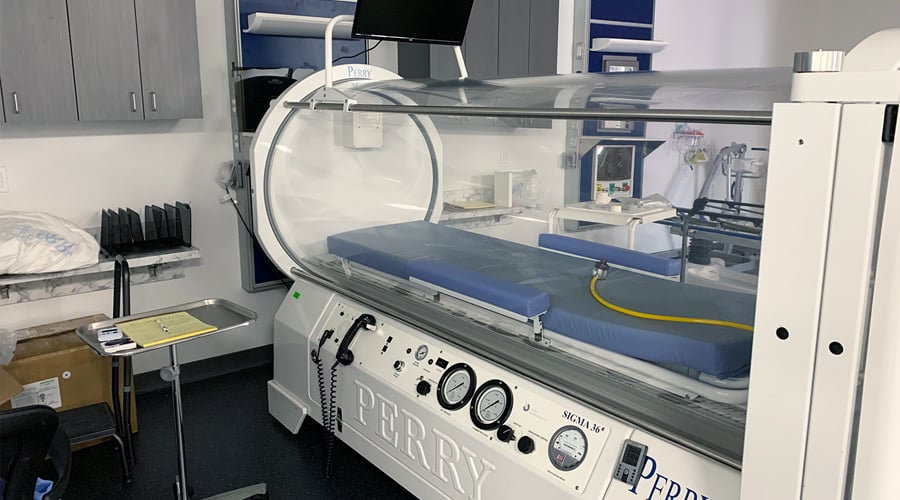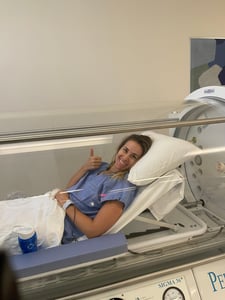For decades, avascular necrosis (AVN) of the femoral head was regarded as a degenerative...
How Long Do the Effects of Hyperbaric Oxygen Therapy Last?

THIS ARTICLE AT A GLANCE:
A common question about HBOT is how long will its effects last. While patient outcomes vary, benefits can persist for weeks, months, or even permanently, depending on individual factors.
Hyperbaric oxygen therapy (HBOT) is a well-established and well-studied medical treatment that has been used for many years. It involves breathing pure oxygen in a pressurized chamber, which forces more oxygen into the bloodstream. HBOT is used to treat a variety of conditions, including chronic wounds, acute carbon monoxide poisoning, certain infections and other forms of tissue damage.
One of the most common questions people ask about HBOT is how long the effects last. This blog post will explore this question in detail:
- What is HBOT?
- What are the benefits of HBOT?
- How often should you do HBOT?
- How Quickly Will I Feel Results after HBOT?
- How long do the effects of HBOT last?
What Is Hyperbaric Oxygen Therapy?
Hyperbaric oxygen therapy (HBOT) is a medical treatment that involves breathing pure oxygen in a pressurized chamber. The increased pressure forces more oxygen into the bloodstream, which can help to heal wounds, improve circulation, and fight infection.
HBOT is used to treat a variety of conditions, including:
- Chronic wounds, such as diabetic foot ulcers and pressure sores
- Decompression sickness
- Osteomyelitis (bone infection)
- Traumatic Brain Injuries and Concussions
- Radiation injuries
- Sudden Hearing Loss
- Auto-immune diseases
- Inflammatory Bowel Disease
- Stroke recovery
 HBOT is performed in a special chamber called a hyperbaric chamber. The chamber is pressurized to two to three times the normal atmospheric pressure. This increased pressure forces more oxygen into the bloodstream.
HBOT is performed in a special chamber called a hyperbaric chamber. The chamber is pressurized to two to three times the normal atmospheric pressure. This increased pressure forces more oxygen into the bloodstream.
During HBOT, the patient lies or sits comfortably inside the chamber. The treatment typically lasts for 60 to 90 minutes.
What Are the Benefits of HBOT?
However, some of the most common benefits of HBOT include:
- Increased healing of wounds
- Improved circulation
- Reduced inflammation
- Increased production of new blood vessels
- Improved oxygenation of tissues
- Mobilization of stem cell
- Improve immune function
How Quickly Will I Feel the Benefits?
The effects of HBOT can vary depending on the individual and the condition being treated. Some people may feel the effects of HBOT immediately, while others may not feel them for several days or weeks into their treatment plan.
The doctor will develop a treatment plan for each patient based on their individual needs. The treatment plan will include the number of treatments needed, the frequency of treatments, and the length of each treatment.
How Often Should I Do HBOT?
The frequency of HBOT treatments will vary depending on the individual and the condition being treated. Generally, HBOT treatments are given daily, five days per week. The number of treatments needed can range from a few to 40 or more, depending on the condition and severity.
For example, people with acute carbon monoxide poisoning may only need one or two HBOT treatments. People with chronic wounds may need 40 or more HBOT treatments.
Your doctor will develop a personalized treatment plan for you based on your individual needs. The treatment plan will include the number of treatments needed, the frequency of treatments, the atmospheric pressure prescribed, and the length of each treatment.
How Long Do the Effects of HBOT Last?
The effects of HBOT can last for several weeks or months, and in some cases, they may be permanent. The duration of HBOT effects depends on a number of factors, including the following:
- The condition being treated
- The number of HBOT treatments received
- The frequency of HBOT treatments
- The individual's overall health
For example, HBOT can be used to treat chronic wounds, such as diabetic foot ulcers. HBOT can help to heal these wounds and prevent them from recurring.
HBOT can also be used to improve circulation in people with peripheral artery disease (PAD). PAD is a condition in which the arteries in the legs become narrowed or blocked. HBOT can help improve blood flow to the legs which then reduces symptoms of PAD.
HBOT aids in the treatment of chronic refractory osteomyelitis, a bone infection, and the effects of HBOT on osteomyelitis can last for several months or even years.
HBOT can help to improve the recovery of people with certain types of brain injuries, such as traumatic brain injury (TBI), concussions and stroke. The effects of HBOT on brain injuries can last for several months or years or can even be permanent.
Factors that can affect the duration of HBOT effects:
- The individual's age
- The individual's lifestyle
- The individual's diet
- The individual's smoking status
- The individual's other medical conditions
Before & After HBOT
Before HBOT:
Before beginning hyperbaric oxygen therapy (HBOT), patients may experience a mix of emotions, including hopefulness and anxiety. Living with conditions such as chronic wounds or traumatic brain injuries can be physically and emotionally draining. To prepare for HBOT, eat a balanced meal and stay hydrated before your treatment. Stop the use of tobacco during your treatment period. Do not wear perfumes, make-up, lotion, hair products, or acrylic nails. Be sure not to drink alcohol, soda or carbonated beverages before treatment.
After HBOT:
After completing a HBOT session, patients may feel some temporary side effects like fatigue or light-headedness, which typically dissipate quickly. It's crucial to prioritize rest and hydration and follow post-treatment guidelines provided by healthcare professionals. Over time, many patients report improvements in energy levels, pain reduction, enhanced cognitive function, and accelerated wound healing. By staying hydrated, getting adequate rest, and maintaining a positive outlook, patients can optimize their recovery and embrace the potential benefits of HBOT.
HBOT Under Medical Supervision
At Hyperbaric Medical Solutions, safety is our highest priority. To that end, every patient at our clinics is seen and cleared by a certified hyperbaric professional to ensure all potential contraindications are addressed prior to going into a hyperbaric chamber.
Additionally, all patient treatment plans are individually prepared by a hyperbaric board-certified physician, and each session is closely supervised by hyperbaric certified medical staff and trained technicians.
To ensure your safety, we strongly urge that you receive hyperbaric oxygen therapy under strict medical supervision.
Conclusion
HBOT is a safe and effective treatment for a variety of conditions, but it is important to find a trusted provider and seek care in a setting with medical oversight. By following these tips, you can help to ensure that you receive the best possible care and long-lasting results.
Schedule a free-15 minute phone call with one of our Patient Care Coordinators to find out more about the cost of HBOT for your unique situation and get all your other questions asked.

Written by Alan Katz, MD, FUHM, FACEP, FAAEM
Dr. Alan Katz, National Medical Director of Hyperbaric Medical Solutions (HMS), is double board certified in Emergency Medicine and Hyperbaric Medicine. He directs clinical operations, education and research initiatives, and the integration of other regenerative medicine therapies....
Read More



